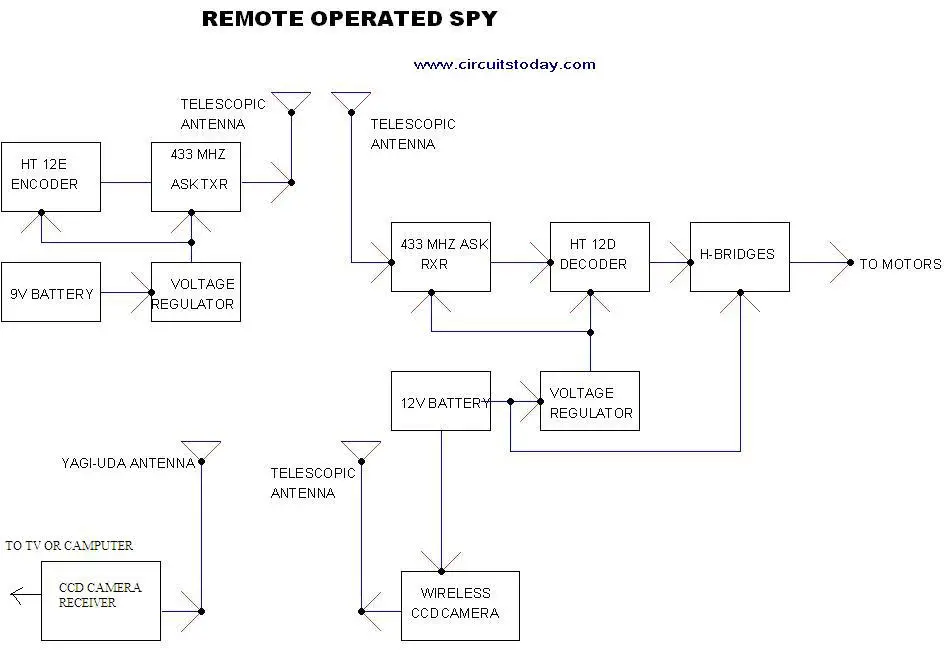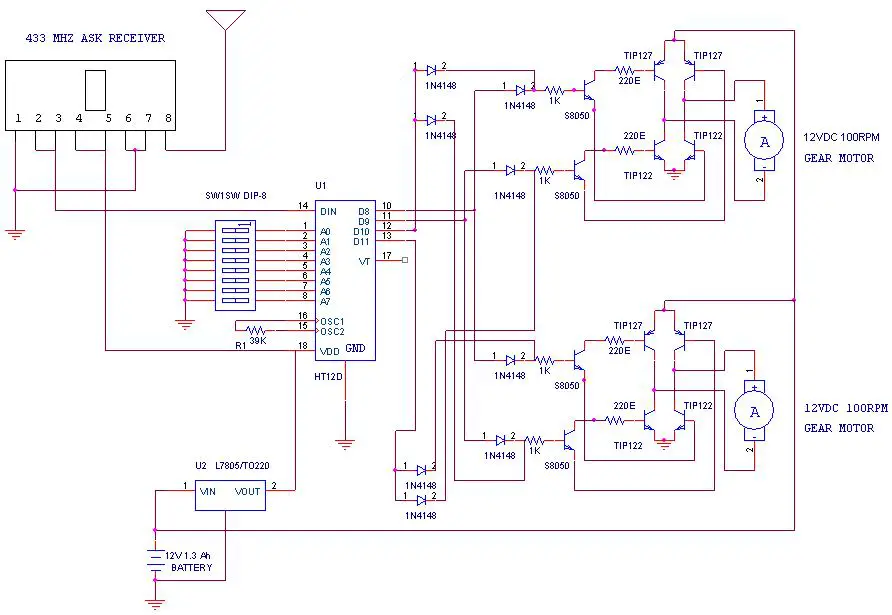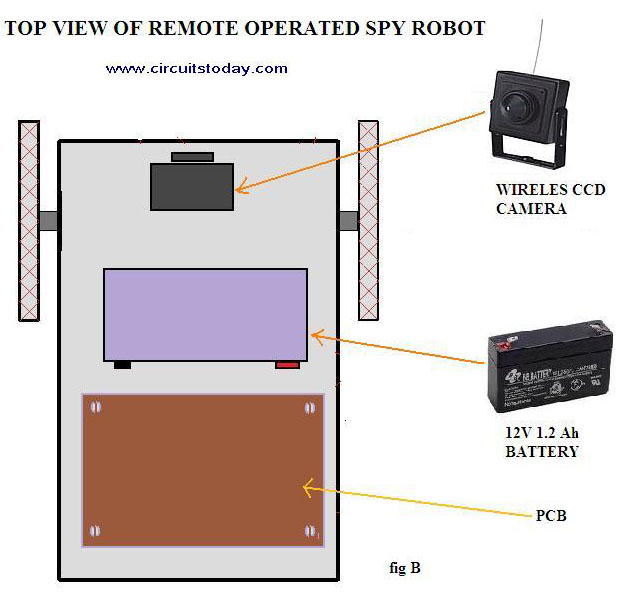Here is a remote operated spy robot
circuit which can be controlled by using a wireless remote controller.
It can capture audio and video information’s from the surroundings and
can be sent to a remote station through RF signals. The maximum range is
125 meters. It overcomes the limited range of infrared remote
controllers. This robot consists of mainly two sections. They are
explained in detail below.
Remote Control Operated Spy Robot Circuit – Block Diagram
1. Remote Control Section
The circuit uses HT 12E, HT 12D encoder
and decoder. 433MHz ASK transmitter and receiver is used for the remote
control. H-bridge circuits are used for driving motors. Two 12V
DC/100RPM gear motors are used as drivers. The working of the circuit is
as follows.
When we are pressing any key in remote
controller the HT 12E generate 8 bit address and 4 bit data .The DIP
switches are used for setting the address. Then the ASK transmitter
sends the 8 bit address and 4 bit data to the receiver Then the ASK
receiver receives the 8 bit address and 4 bit data and HT 12D decoder
decodes the data, thus enabling the appropriate output. Thus the output
signals that are generated controls the H-bridge which then rotates the
motors.
The 433 MHZ ASK transmitter and
receivers are extremely small, and are excellent for applications
requiring short-range RF remote controls. The transmitter module is
only 1/3rd the size of a standard postage stamp, and can
easily be placed inside a small plastic enclosure. The transmitter
output is up to 8mW at 433.92MHz. The transmitter accepts both linear
and digital inputs and can operate from 1.5 to 12 Volts-DC, and makes
building a miniature hand-held RF transmitter very easy. The 433 MHZ
ASK transmitters is approximately the size of a standard postage stamp
433 MHZ ASK receivers also operate at 433.92MHz, and have a sensitivity of 3uV. The receiver operates from 4.5 to 5.5 volts-DC.
2. Video Transmission Section
In this project we are using a wireless
CCD camera. Now these types of cameras are commonly available in the
market. It works on 12VDC supply.
The 12 Volt DC supply is taken from the
battery placed in the robot. The camera has a receiver, which is placed
in the remote station. Its output signals are in the form of audio and
video. These signals are directly connected to a TV receiver or a
computer through a tuner card.
Components Required
| IC | HT 12E | 1 |
| HT 12D | 1 | |
| LM 7805 | 2 | |
| TRANSISTOR | TIP 127 | 4 |
| TIP 122 | 4 | |
| S 8050 | 4 | |
| DIODE | 1N 4148 | 8 |
| RESISTOR | 1K | 4 |
| 220E | 4 | |
| 39K | 1 | |
| 1M | 1 | |
| ASK TRANSMITTER | 433 MHz | 1 |
| ASK RECEIVER | 433 MHz | 1 |
| DIP SWITCH | 2 | |
| PUSH TO ON SWITCH | 4 | |
| GEAR MOTOR | 12V DC 100rpm | 2 |
| BATTERY | 12V 1.3 Ah rechargeable | 1 |
| 9V | 1 | |
| WIRELESS CCD CAMERA | 1 |
Construction
The steps for the construction are…
1. Take a hylam sheet with (20cm*15cm) size.
2. Fix two gear motors (12VDC 100rpm) in the hylam sheet by using aluminum pieces and nut bolts as shown in the figure below.
3. Fix the ball castor as shown in the figure below.
4. Then fix the battery (12VDC 1.2Ah) on the top of the spy robot as shown in the figure below.
5. Connect two motors to the PCB. The PCB is then connected to the battery.
6. Connect the wireless CCD camera to the battery.
7. Connect the camera receiver to the TV or computer. Video information’s will thus appear in the screen.
8. Switch on the remote controller and control the spy robotSource: http://www.circuitstoday.com/
Share this on your favourite network












If you take a look at this article http://trackingapps.org/cell-phone-spy-software-remote-installation/ you will realize that it's almost impossible to install soft remotely without attending top-hacking skills
ReplyDelete